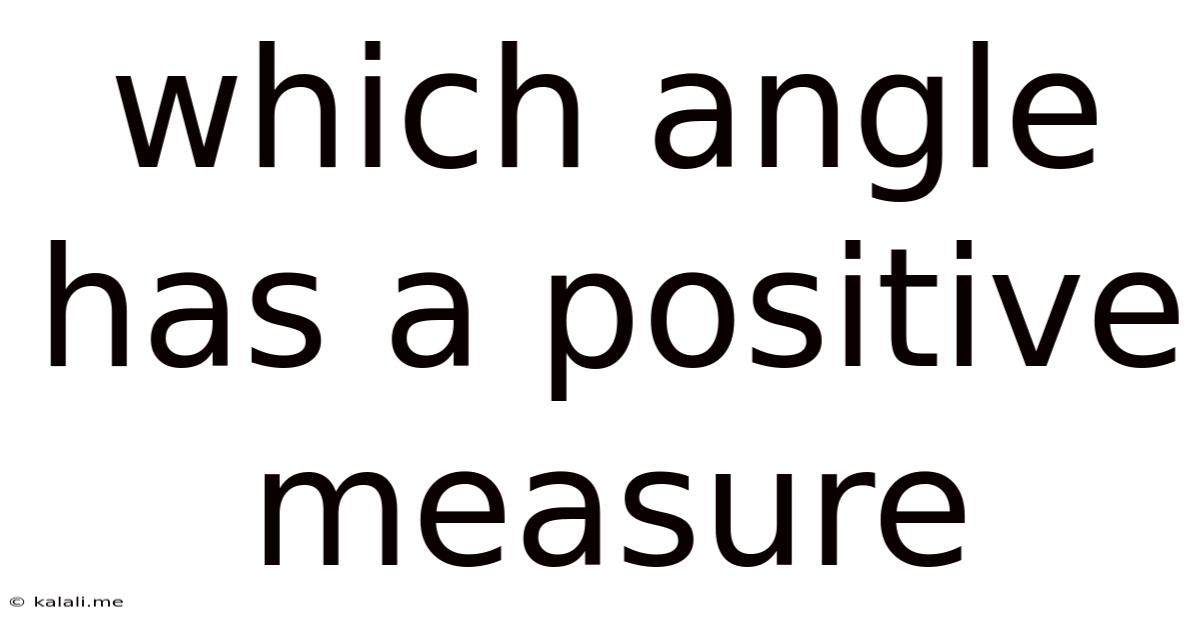Which Angle Has A Positive Measure
Kalali
Jun 11, 2025 · 2 min read

Table of Contents
Which Angle Has a Positive Measure? Understanding Angle Measurement
This article will delve into the fascinating world of angles and explore the concept of positive and negative angle measures. Understanding this is crucial for various mathematical applications, including trigonometry, geometry, and calculus. We'll clarify which angles have positive measures and why, providing a solid foundation for anyone working with angles.
What is an Angle?
Before diving into positive measures, let's define what an angle actually is. An angle is formed by two rays sharing a common endpoint, called the vertex. These rays are often referred to as the sides or arms of the angle. Angles are typically measured in degrees (°), radians (rad), or gradians (grad), but degrees are the most commonly used unit for this discussion.
Measuring Angles: The Standard Position
Angles are usually measured in relation to a standard position. In the standard position, the vertex of the angle is at the origin (0,0) of a coordinate plane, and one ray, called the initial side, lies along the positive x-axis. The other ray, called the terminal side, rotates around the origin.
Positive vs. Negative Angle Measures
The measure of an angle is determined by the direction and amount of rotation of the terminal side from the initial side.
-
Positive Angle Measure: A positive angle measure indicates a counter-clockwise rotation of the terminal side from the initial side. Imagine the terminal side moving in the same direction as the numbers on a clock, but moving against the clock's hands.
-
Negative Angle Measure: A negative angle measure indicates a clockwise rotation of the terminal side from the initial side. This is the opposite direction of a positive angle, moving with the clock's hands.
Identifying Angles with Positive Measures:
Therefore, any angle formed by a counter-clockwise rotation from the initial side (positive x-axis) will have a positive measure. This applies to angles of any size, whether they are acute (less than 90°), obtuse (between 90° and 180°), reflex (between 180° and 360°), or greater than 360°.
Examples of Angles with Positive Measures:
- 30°: A small, acute angle formed by a counter-clockwise rotation of 30 degrees.
- 150°: An obtuse angle formed by a counter-clockwise rotation of 150 degrees.
- 270°: A reflex angle formed by a counter-clockwise rotation of 270 degrees.
- 400°: An angle greater than 360°, representing one full rotation plus an additional 40 degrees counter-clockwise.
In summary: The key to identifying an angle with a positive measure is to observe the direction of rotation of the terminal side from the initial side. A counter-clockwise rotation always results in a positive angle measure, regardless of the angle's size. Understanding this fundamental concept is essential for mastering various aspects of geometry and trigonometry.
Latest Posts
Latest Posts
-
Stp S16 Oil Filter Fits What Vehicle
Jul 01, 2025
-
Which One Of The Gatlin Brothers Passed Away
Jul 01, 2025
-
Do Naked And Afraid Contestants Get Paid
Jul 01, 2025
-
How Many Bottles Of Water Is 64 Oz
Jul 01, 2025
-
Was Brigham Young Stabbed By One Of His Sons
Jul 01, 2025
Related Post
Thank you for visiting our website which covers about Which Angle Has A Positive Measure . We hope the information provided has been useful to you. Feel free to contact us if you have any questions or need further assistance. See you next time and don't miss to bookmark.